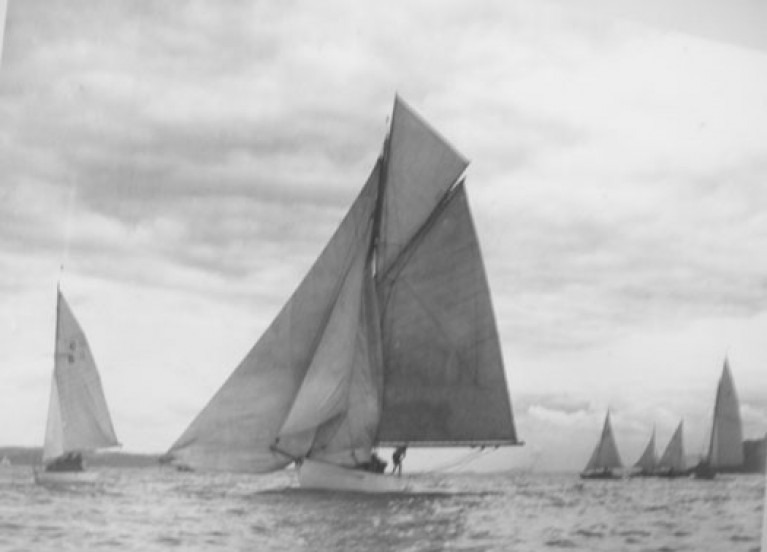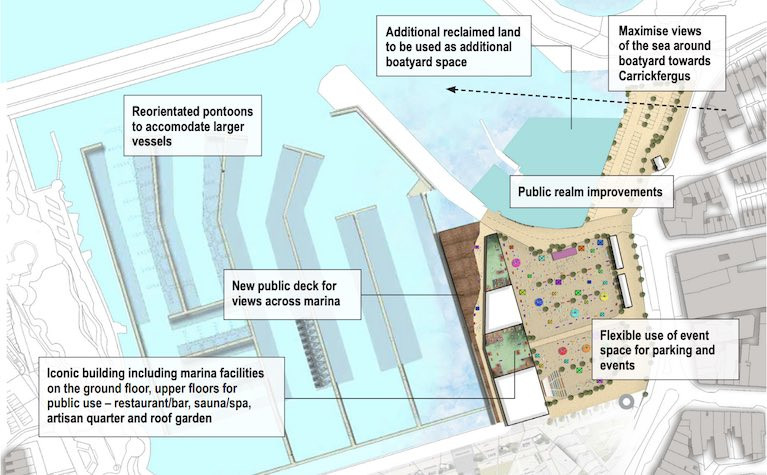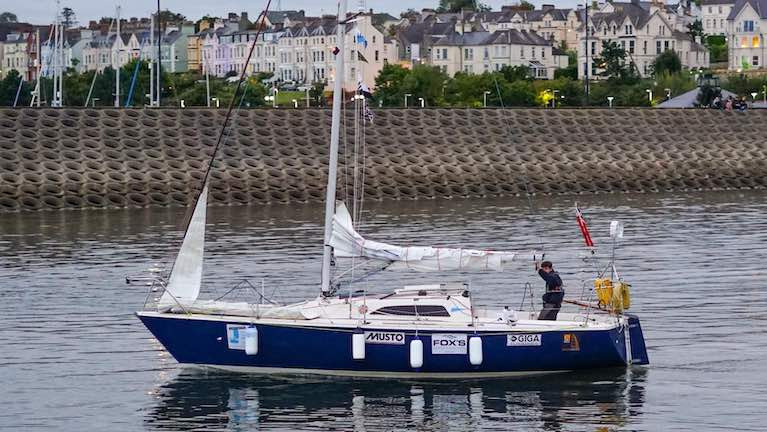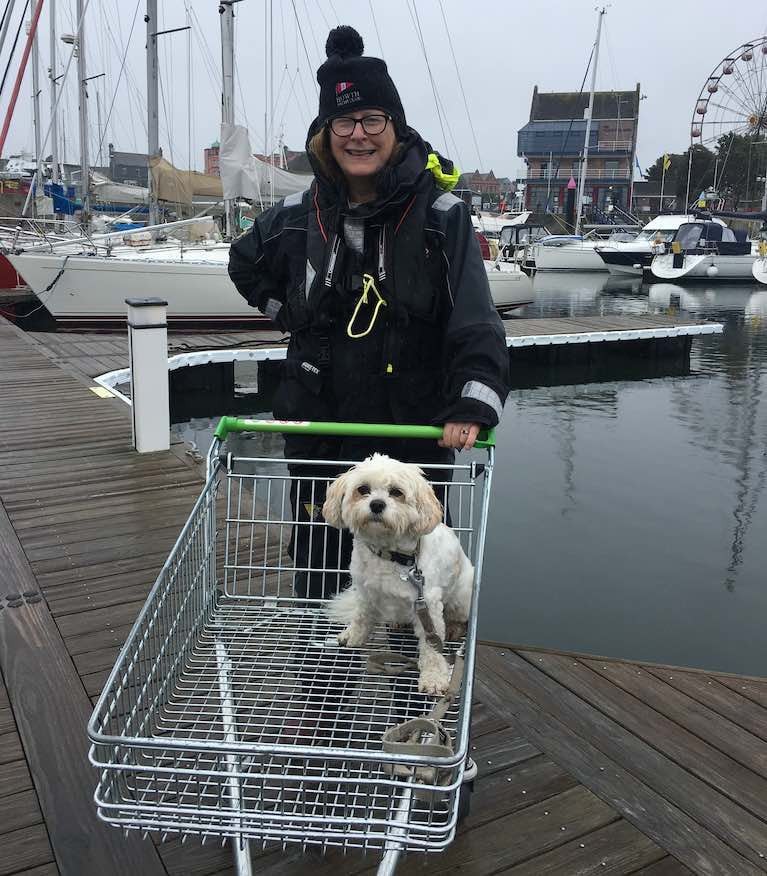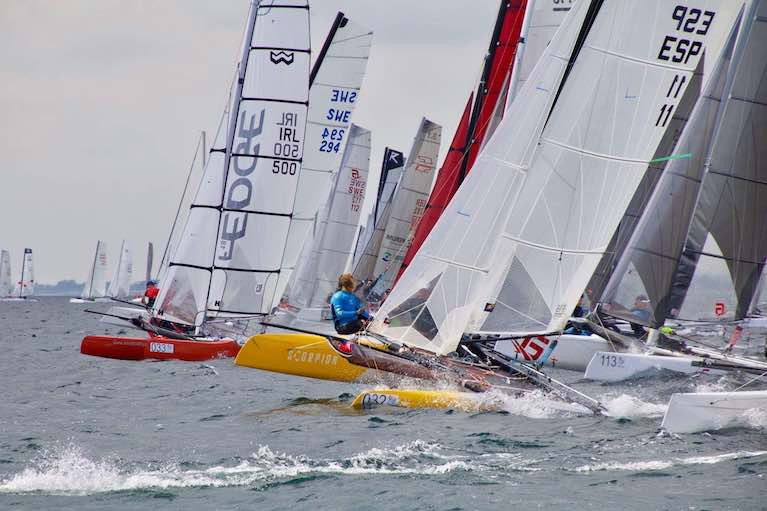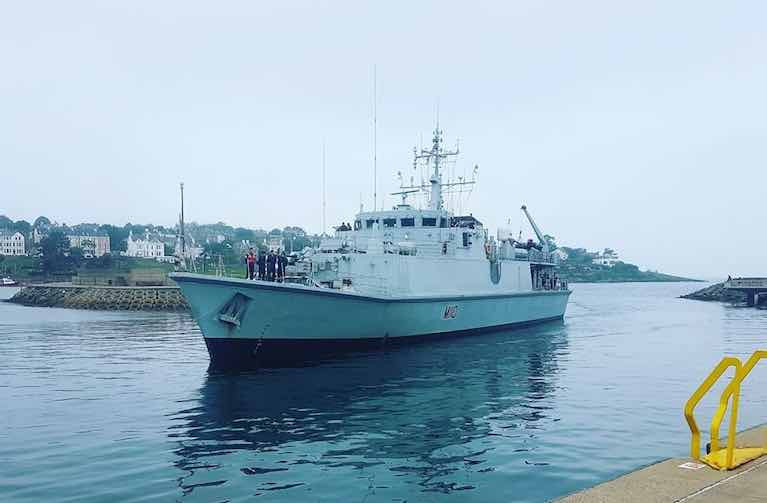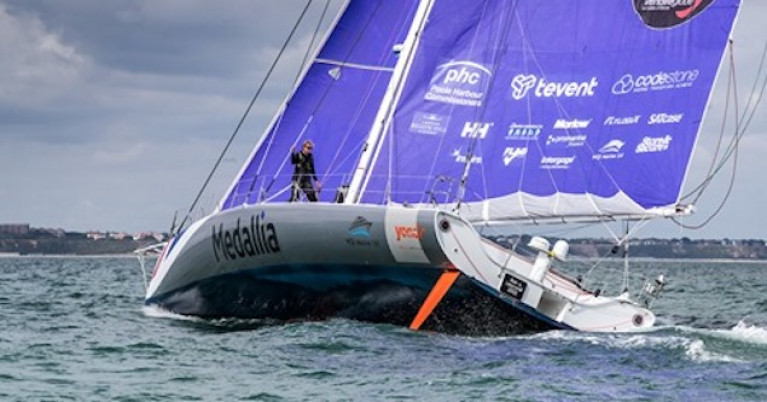Displaying items by tag: Belfast Lough
Irish sailing's September Song Made Sweeter by its Brevity
Thank you, September. You did your best to provide us with good sailing as ingenious moves were implemented to run modified pandemic-compliant events which gave proper meaning to the season, and to our sailing traditions. It was neither your fault - nor ours - that in some places a situation beyond everyone's control caused a severe foreshortening of programmes carefully tailored to deal with circumstances which then seemed to change on a daily or even hourly basis.
For sure, some fortunate sailing centres managed to have limited sailing all month, scraping weekly sport out of the last of the daylight as the evenings rapidly closed in, and working the weekends with skill. But in other locations, the guillotine slammed down at mid-month, and people found that whatever good sailing they might have experienced now had to become recalibrated in the memory bank as highlights of their very truncated sailing year.
ROYAL CORK MAKES THE BEST OF IT
No club more thoroughly deserved a final full month of good fortune in September than the Royal Cork in Crosshaven, as they emerged battered but unbowed from what should have been their globally-focused Tricentenary. Most appropriately it was that renowned backbone-of-the-club, the National 18s, which saw September out with a flourish on its very last day, racing up and down the Owenabue River off the clubhouse on Wednesday evening as the twilight settled gently until this all-important month of September had only a matter of hours to run.
 Twilight for the Gods…..the National 18s at Royal Cork managed their last evening race – an in-river event off the clubhouse – on Wednesday, September 30th. The winner was Nick Walsh's Fifty Shades. Photo: Robert Bateman
Twilight for the Gods…..the National 18s at Royal Cork managed their last evening race – an in-river event off the clubhouse – on Wednesday, September 30th. The winner was Nick Walsh's Fifty Shades. Photo: Robert Bateman
With some more good luck, the club will be able to continue its Autumn League this weekend, but meanwhile like other sailing centres, Crosshaven and Cork Harbour found that September presented unusually meaningful opportunities to stage events which celebrated the places of sailing and its people, and in Cork Harbour, the come-all-ye event which best does this is Cove SC's annual Cobh to Blackrock Race.
Even though the Royal Cork had experienced its 2020 highlight in being the finish point for the successful pop-up Fastnet 450 Race in August, the Cobh-Blackrock Race is an ancient piece of the harbour's fabric, and September obligingly provided the conditions for a fast race and a real sense of occasion with life going on regardless.
 The Golden Oldie comes to town. The restored 1898 Cork Harbour One Design Jap, raced by Royal Cork Admiral Colin Morehead, reaches the finish of the Cobh-Blackrock Race. The CHODs are renowned for their pleasant steering characteristics - even on this gusty day, Jap's tiller is still in a very manageable fore-and-after position. Photo: Robert Bateman
The Golden Oldie comes to town. The restored 1898 Cork Harbour One Design Jap, raced by Royal Cork Admiral Colin Morehead, reaches the finish of the Cobh-Blackrock Race. The CHODs are renowned for their pleasant steering characteristics - even on this gusty day, Jap's tiller is still in a very manageable fore-and-after position. Photo: Robert Bateman
DUN LAOGHAIRE'S COMPACTED SEASON DEALT SUCCESSFULLY WITH REALITY
In Dun Laoghaire, Dun Laoghaire Motor Yacht Club's annual Kish Race is something that should in time be seen as a celebration of Dublin Bay, and in September 2020 is was shaping up that way as other events got the chop because of their inevitably high sociability quotient. Entries were flying up as racing round the Kish became more desirable than ever, but with a couple of days to go, the latest set of regulations wiped the race off the blackboard. That said, now that we know how much it can mean to the Dun Laoghaire sailing community, it's surely an all-comers cruiser-racer event which deserves more oomph in the future.
Meanwhile, as we write this there's still hope that some more racing will be squeezed out of Dun Laoghaire before the year is out. But for now, the image which best expresses the year and September in particular in its own special style is our header photo, which came our way on Thursday, September 17th from Cathy MacAleavey, and showed the finish of the previous evening's Water Wag Race, when 24 boats sailed in what might just turn out to be the last regular official race in Dun Laoghaire in 2020.
Thus what is already a richly atmospheric photo acquires extra meaning as Tim Pearson and his son Marcus in their 1995-built Little Tern cross first, narrowly ahead of Ian & Judith Malcolm in the 1915-built Barbara, while Martin and Triona Byrne in the 2019-built Hilda come in toward a third-place on port tack. There's a whole universe in that photo and it's one of the gifts which September's sailing has given us.
 The Goodbody family's J/109 White Mischief was one of the most successful contenders in Dublin Bay SC's compacted but very busy season. Photo Afloat.ie
The Goodbody family's J/109 White Mischief was one of the most successful contenders in Dublin Bay SC's compacted but very busy season. Photo Afloat.ie
But another gift in Dun Laoghaire Harbour was the way Dublin Bay SC managed to keep things going from mid-July to mid-September, with evening and weekend racing for cruisers, keelboat and dinghies pushing comfortably over the hundred boat mark in a successfully-controlled operation which was a model of compliance.
HOWTH FINDS HEART IN LAMBAY
Round the corner in Howth meanwhile, although their time-honoured annual race round Lambay was to disappear in the cancellation of the Wave Regatta in which it now plays a central role, when the carefully-monitored Aqua Double-Hander was staged in July with 38 boats, it was raced round Lambay on a day of sublime sunshine which eventually may result in the summer weather of 2020 being remembered as even better than it actually was.
 This was September 2020 – the Howth 17's Leila and Anita in the race round Lambay. Photo: Annraoi Blaney
This was September 2020 – the Howth 17's Leila and Anita in the race round Lambay. Photo: Annraoi Blaney
Yet it was back to classic Atlantic westerlies in on some days in September when the heroically curmudgeonly veterans of the 122-year-old Howth Seventeen Class decided they'd race round Lambay on September 5th, with the winning 1907-built Deilginis seeing off the 16 miles course in a record time. This was in a race which was started in sunshine captured by rising photographic star Annraoi Blaney in a striking shot which will now be one of the style-setting photos of this brief but sweet sailing season.
They'd a longer burst of September sunshine in Howth at mid-month when the Autumn League got underway, each weekend's racing spread over both days but only one day of racing for each class, which helped social distancing as they'd 79 boats entered in all for what turned out, alas, to be just one weekend before the chop.
 "Just the best day's sailing ever". Simon Knowles' J/109 Indian in hot pursuit of the Classic Half Tonners Mata, King One and Big Picture in the first (and so far only) weekend of the Howth Autumn League. Photo: Judith Malcolm
"Just the best day's sailing ever". Simon Knowles' J/109 Indian in hot pursuit of the Classic Half Tonners Mata, King One and Big Picture in the first (and so far only) weekend of the Howth Autumn League. Photo: Judith Malcolm
If the Dublin Shutdown really does become just a three-week imposition, then it will be everything up and running again after midnight on Friday, October 9th. But we don't see anyone betting on that, and for now, the Howth recollections of September sailing are best summed up by J/24 National Champion Sam O'Byrne, who was racing in Howth with father-and-son superstars Darren and Rocco Wright on the winning Classic Half Tonner Mata in that one opening race, with Sam subsequently commenting: "It was the best and pleasantest day of sailing I've ever had, full stop".
BELFAST LOUGH CELEBRATES DIVERSITY WITH LUFRA CUP
Up on Belfast Lough the celebration of the local sailing waters used to happen on the 12th July, when folk ashore had marching business on their mind, but those afloat at Ballyholme traditionally had a day-long race right round the lough. This was easily done thanks to conveniently placed navigation markers at every corner, such that you'd to face a course which could seem very long indeed if you were racing it in one of the 18ft Waverley Keelboats, or the 22-footers of the Bay Class.
However, that's a classic of the olden days which no longer seems to be sailed, but another Ballyholme tradition which is still going strong to celebrate the local sailing water is the Lufra Cup, which Betty Armstrong of this parish was reporting a couple of weeks ago. Nobody knows when this pursuit race – they called it the Menagerie Race until Howard Finlay presented the Lufra Cup after his 12-ton Watson cutter of that name had won in 1943 to find there as no proper cup – and ever since the Lufra Cup has been Ballyholme YC's September Classic, a race officer's nightmare and a handicapping anorak's dream, with boats streaming across the starting line in an endless procession of different starting times, and the finish seeing half a dozen boats of very different types trying to get across that line first, with a 15-ton gaff cutter winning one year, and an International Cadet winning it the next with the 15-tonner's bowsprit right over her very junior helm as he crossed the line.
 Once a winner of the Lufra Cup at Ballyholme, the 1893 Dun Laoghaire-built Marie was designed by Maimie Doyle, who later designed the transom-sterned Water Wags. Photo: W M Nixon
Once a winner of the Lufra Cup at Ballyholme, the 1893 Dun Laoghaire-built Marie was designed by Maimie Doyle, who later designed the transom-sterned Water Wags. Photo: W M Nixon
This September it was won by Gareth Martel in his Beneteau First 40.7 Pippa, and he found himself the custodian for a year of a trophy which is a significant historical record in itself, for the inscribed list of winners going back 77 years is a history of the development of sailing of the last three-quarters of a century.
Every conceivable boat type seems to have figured at some stage, including Lasers sailed by Chris Boyd and Wic McCready, and the venerable 26ft gaff cutter Marie, designed by Maimie Doyle in Dun Laoghaire in 1893, built by her father J E Doyle, and now owned by Roy Ashton of Groomsport after a lifetime of epic sailing history which included being the first boat to be awarded the Irish Cruising Club's Faulkner Cup back in 1931.
LOUGH REE, CONNEMARA & GLANDORE
Thanks to September's sailing, we were reminded of such things, but equally, September 2020 brought together past and present and future in dynamic ways, a good example being the Jonny Swan-organised Homecoming Regatta at the 250-year-old Lough Ree Yacht Club which saw cruisers, dinghies, Shannon One Designs and SB20s finding brisk breezes and sunshine.
 SB20 racing on Lough Ree with September 2020 Junior Sailor of the Month Ben Graf on the helm. Photo: Alex Hobbs
SB20 racing on Lough Ree with September 2020 Junior Sailor of the Month Ben Graf on the helm. Photo: Alex Hobbs
Then too, September reminded us that a thriving Flying Fifteen Class continues to develop in the heart of Connemara at Casla, with 27 boats appearing for an on-going league from all the hidden places in that totally inter-twined Land of the Sea, and Ronan O'Briain winning the two last races of September at the weekend.
 A new tradition in the heartland of traditional boats? September racing for the growing fleet of Flying Fifteens at Casla in Connemara
A new tradition in the heartland of traditional boats? September racing for the growing fleet of Flying Fifteens at Casla in Connemara
The Flying Fifteen is not a boat type you would automatically associate with the very traditional waters of Connemara. Yet equally not everybody would think that the International Dragon is a useful youth trainer. But Don Street of Glandore on the south coast is firmly of the opinion that they are, and as Don celebrated his 90th birthday with some style among his beloved Dragons in Glandore at the end of July, his opinions deserve respect, and his programme of youth training with Dragons continued into September with some helms as young as thirteen.
 You may see the Dragons racing at Glandore, but veteran skipper Don Street also sees a useful sail training flotilla….. Photo: Kathleen Hayes
You may see the Dragons racing at Glandore, but veteran skipper Don Street also sees a useful sail training flotilla….. Photo: Kathleen Hayes
However, as they lie to moorings off that most picturesque village, the Glandore Dragons have a set season, and last weekend they raced on Saturday morning, and then lifted in the afternoon to bring their season to a close. Meanwhile, for places with marinas, there are all sorts of possibilities of being able to fit in some sailing provided regulations don't become totally strict across the board.
But for now, let's just be very grateful that September has done the business to be such a very valuable part of this difficult 2020 season.
The History of Belfast Lough's Lufra Cup for the Menagerie Sailing Race
It's 76 years since the Lufra Cup was first presented to the winner of Ballyholme's Menagerie Race, a pursuit event run traditionally to mark Closing Day when there was no such thing as Winter, let alone Autumn racing in Belfast Lough. And that winner was Howard Finlay in his cutter, Lufra, who had himself given the cup to the club in 1944 as the Menagerie Race was trophyless.
 Howard Finlay (second left) and crew on board Lufra 1938 Photo: courtesy Paul Finlay
Howard Finlay (second left) and crew on board Lufra 1938 Photo: courtesy Paul Finlay
This year it was won by Gareth Martel in his Beneteau 40.7 Pippa, in a mixed fleet of 50 keelboats and dinghies. The strong southerly gusting 25 knots didn't bode well for the dinghies but provided exciting sailing, giving at least one, Robin Gray in his Aero, 13. 5 miles with an average speed of 5 knots on his tracker!
 The Lufra Cup today
The Lufra Cup today
The name of the cup derived from the 40ft 12-tonner gaff-rigged cutter Lufra designed by GL Watson in 1894 and built by P R Maclean of Rosneath for T K Laidlaw of Glasgow. Lufra was brought to Northern Ireland in 1937 by Howard Finlay whose descendants are still associated with Ballyholme. He won the 1943 Menagerie Race.
 Lufra in her youth, tearing along on the Clyde in the 1890s Photo: courtesy Iain McAllister
Lufra in her youth, tearing along on the Clyde in the 1890s Photo: courtesy Iain McAllister
Afloat's WM Nixon relates here " but as there was no decent prize available, Howard put up the Lufra Cup for the 1944 race which he won. But some Bay Class types weren't quite so chuffed and suggested that as Howard Finlay had presented the new cup, the right thing to do would be to hand it on to the boat which finished second. He told them very precisely what they could do with that notion".
During the 50s Lufra became expensive to run and unsellable, and as the keel was worth more than the boat itself, this was sold and the boat left to rot and sink in the Quarry Hole harbour in Donaghadee, from where it was sadly dumped when the new marina was built there in the 60s.
 Gareth Martel's First 40.7 Pippa Photo: courtesy Yachting Images
Gareth Martel's First 40.7 Pippa Photo: courtesy Yachting Images
Gareth Martel's Pippa couldn't be more different from Lufra and he joins the long list of winners which includes boats as diverse as a Hurricane, a 505, a Laser and last year's winner, an RS Elite. But one winning boat which was similar to Lufra, in age anyway, was the two berth 5 tonne 25 ft gaff cutter, Marie, built-in 1893 in Howth, reputedly designed by a Miss EW Doyle of the builder's family.
Marie won the Lufra Cup in 1961 with Martin Imrie and his son, also Martin, on board. Unlike Lufra and despite being washed ashore in an early 1960s gale, she was saved and restored but is laid up today.
 Marie (built 1893) pictured circa 1960
Marie (built 1893) pictured circa 1960
- Built: 1893, Howth, of yellow pine on oak. Designed by a Miss EW Doyle of Howth, I think, of the builder's family.
- Rig: Gaff Cutter. Tonnage: 5 T.M. Length overall: 25 feet 7 inches.
- Beam: 7 feet 1 inch. Length on waterline: 24 feet. Draft: 4 feet 6 inches.
- Sail area: 360/420 square feet. Engine: none. Berths: two.
She was wrecked sometime between 1962 and 1965, I think, when she broke her moorings (or was she just anchored?) in the usual early Autumn NE gale, around the time of that year's Menagerie race. We salvaged her from the beach on the next tide and got her into the shipyard. She was then sold to Mike McKee, who had her refastened and she is still sailing somewhere.
All Change in £40m Plan for Bangor Waterfront on Belfast Lough
Bangor on Belfast Lough is hoping to secure through Ards and North Down Borough Council, around £40m from the Belfast City Regional Deal to fund the Bangor Waterfront Development and will submit the Outline Business Case to the Belfast Region City Deal in October. The outcome of the bid will be confirmed by the end of 2020 and if successful, the Council will contribute a further £20M approximately and the private sector about £4M to the project.
The Belfast Region City Deal (BRCD) offers a bespoke package of funding from Westminster to help achieve inclusive economic growth across the Belfast region, and the business case will detail concept proposals for five key regeneration projects.
This plan aims to redevelop a two-mile stretch of the seafront to re-establish Bangor as a thriving town and prime visitor attraction in Northern Ireland by connecting the waterfront to the rest of the town and, in so doing, provide a unique range of opportunities for residents and visitors to have their lives and businesses enriched by a mix of public spaces, creative events, activities, attractions and experiences that speak of local stories to a global audience.
 This plan aims to redevelop a two-mile stretch of the seafront to re-establish Bangor as a thriving town and prime visitor attraction in Northern Ireland
This plan aims to redevelop a two-mile stretch of the seafront to re-establish Bangor as a thriving town and prime visitor attraction in Northern Ireland
The projects encompass sections of the coastline. Skippingstone Beach, popular with sea swimmers, at the west end of the area and overlooking the entrance to the Harbour, will benefit from multi-use pods for beach activities, accessibility features, feature lighting/benches; Pickie Family Fun Park will be enhanced with new all-weather attractions for both children and young adults, and an extension to the Pickie Puffer train ride, which will take visitors from Pickie to the Queen's Parade area closer to the town centre. For Bangor Marina, the 530 berth Five Anchor facility right in the town centre, the proposals recommend redeveloping Bregenz House which houses the Coastguard Station and Marina office and facilities with, on the upper floors, bars, restaurants, an artisan corner and roof garden and a public deck offering views across the marina. Better public access around this building was a clear ask when the public surveys and stakeholder workshops on the development on Bangor Waterfront were undertaken.
In a comment about this particular part of the proposals, a spokesperson for the Council said "We have recognised this in the Outline Business Case (OBC) proposals but would stress that there are a number of steps to work through and matters to be considered before we can confirm whether Bregenz House will be redeveloped or not - most significant being approval of the OBC and provision of funding support from the Belfast Region City Deal. It is our hope that any redeveloped facility will include a range of users - new and existing, including the Coastguard. Initial discussions with the Coastguard indicate that they are keen to be part of the Bangor Waterfront Development plans and we will be engaging with them further as we move this exciting project forward".
 The Bangor town coastline
The Bangor town coastline
The regenerated Bangor Court House opposite the Harbour is earmarked for the Music Hub, a permanent home for the Open House Festival and a much-needed multi-purpose venue serving the town.
Moving east Kingsland, which began life as an amusement park in the early 20th century, is another green area between Bangor town and the suburb of Ballyholme currently with tennis courts, pitch and put and a dog park – here it is aimed to have café kiosks, a skate park and accommodation;
Nearby is Ballyholme Yacht Club which has been identified as the preferred location in Northern Ireland for major sailing and water sports events by the Royal Yachting Association. The redevelopment of BYC would provide Bangor with a world-class facility for water sports and the ability to host international events.
Welcoming the plans, Mayor of Ards and North Down, Councillor Trevor Cummings said: "Bangor has great potential. We need to build on its strengths, particularly its leisure and cultural assets, high-quality environment, and accessibility, to deliver sustainable regeneration. I would stress that these are proposals, rather than confirmed final plans".
Wayne Hemingway of Hemingway Design is part of the design team working on the Waterfront Development. He is co-founder of the fashion house Red or Dead and on the Design Council Chartered Association of Building Engineers (CABE) Committee. He commented " I was struck immediately on coming to Bangor by the beauty of the coastline and the potential in the town.
In designing the Waterfront Development, our research indicated that a series of attractions would offer more sustainable and inclusive benefits for Bangor than a single iconic attraction - particularly for those who live and work in the town".
Kevin Baird, Harbour and Marina Manager are enthusiastic." We are delighted with these concept proposals; they will ensure that the Bangor Waterfront will become a prime attraction for residents and visitors to Northern Ireland. Our vision of allowing safe access to the water for everyone is becoming a reality".
15-Year-Old Solo Round Britain Sailor Arrives in Bangor on Belfast Lough
Timothy Long from Buckinghamshire in England is only 15, and by the time he finishes his fundraising solo sail around Britain, he will have 1,600-miles under his belt.
In his Hunter Impala 28 'Alchemy' Timothy covers around 45 miles a day with some longer passages of up to 100 miles. Due to Storm Ellen and Storm Francis, he expects the trip to take longer than the estimated 6-8 weeks.
Timothy is raising funds for the Ellen MacArthur Cancer Trust. He has been sailing since he was nine, but this is his biggest challenge yet. He left Southampton on 16th July, and his passage took him east along the English Channel and then north up the east coast of England and Scotland. A long time before the trip, Timothy's aim was to go round the north of Scotland, but this was scuppered by Lockdown which delayed the trip by three months, making the venture logistically very difficult as he is due back at school very soon, so he decided upon the Caledonian Canal.
 Bangor Marina Manager Kevin Baird (left) welcomes teen solo sailor Timothy Long
Bangor Marina Manager Kevin Baird (left) welcomes teen solo sailor Timothy Long
From Oban, where he was stormbound for six days, the passage took him into the Clyde through the Crinan Canal and south to Largs and Troon. After another forced halt of two days in Troon, he stopped off in Loch Ryan and then made a challenging passage down the North Channel in a strong Force 6 -7 Northerly in which he came close to a knockdown. Alchemy arrived safely in Bangor Marina on late Saturday evening last.
Reflecting on his efforts, Timothy said " So far the trip has opened my mind! My world has just got so much bigger as well as my thirst for adventure. I am not quite sure what I want to do afterwards, but I want to pursue sailing as my career, especially offshore racing".
Timothy's fundraising page is here
It's only 160 km by road but the passage north from Dublin Bay for the twelve Cruising Association of Ireland crews who set out for Belfast Lough was a great deal more. With stopovers in Carlingford Lough and Ardglass on the way to Bangor and Belfast, those sailors who persisted in what turned out to be mostly disappointing weather conditions were rewarded with a warm welcome in all the marinas visited. It has been three years since the fleet came North and new members were welcomed to the CAI fold.
Led by Commodore Vincent Lundy in Timballoo, the 14-boat fleet mustered at Malahide Yacht Club where they were treated to a Barbecue hosted by Commodore Dan Flavin and his wife Therese. From there, aided by CAI Secretary John Leahy's regular forecast maps, some of which were so highly coloured there could be no mistake about what they told, two left for Carlingford – John McInerney's Nos na Gaoithe and Noel Lappin's Rhiannon. The rest had a lay day.
Friday saw the rest of the fleet head for Carlingford Lough and for those winds were generally NNE and 12 knots with a sloppy sea but relief came when the turn to port at the Hellyhunter Buoy off Cranfield Point brought some sunshine and calm seas. The destination was the marina on the County Louth shore, in that beautiful fiord like lough, where they enjoyed an evening meal.
 Cruising Association of Ireland yachts arrive in Carlingford Lough during the cruise from Malahide to Belfast Lough
Cruising Association of Ireland yachts arrive in Carlingford Lough during the cruise from Malahide to Belfast Lough
 Early morning at Carlingford Marina
Early morning at Carlingford Marina
The next stop was the fishing town of Ardglass on the south Down coast. With the dire forecast of Storm Ellen for the end of the week, three chose the discretion option and planned to head back to Dublin Bay. After Ardglass it was on North to Belfast Lough.
 Ardglass Marina is the only marina between Carlingford and Bangor. It is one of the safest small harbours on the east coast of Ireland thanks to its two breakwaters and deep water.Cruising Association members at Ardglass are (from left) Clifford Brown, John McInerney and Gerry Dunne
Ardglass Marina is the only marina between Carlingford and Bangor. It is one of the safest small harbours on the east coast of Ireland thanks to its two breakwaters and deep water.Cruising Association members at Ardglass are (from left) Clifford Brown, John McInerney and Gerry Dunne
By Wednesday seven of the fleet were tucked up in Bangor – Timballoo, Rhapsody, Rhiannon, Aldebaran, Seod na Farraige, Nos Na Gaoithe and Enigma (John Murphy had the shortest passage having come from his home port of Carrickfergus on the opposite shore). There was plenty of room for Nanuq owned by Pat McCormick, Commodore of Carlingford Yacht Club and Simon Parker's Asile in the sparsely populated Belfast Harbour Marina with surely the most stunning backdrop in Titanic Belfast. And another northern member, David Meeke was in Bangor without his boat, having picked an unfortunate time to antifoul in Carrick!
 The stunning backdrop of the Titanic Belfast
The stunning backdrop of the Titanic Belfast
Royal Ulster Yacht Club was the venue for the end of cruise dinner where on Wednesday evening the gathering assembled, suitably socially distanced, with Vice Commodore Alan Espey welcoming the crews.
Commodore Vincent Lundy reflected on the event." It is very difficult to organise any event which complies with COVID 19 regulations. The CAI is very particular to the point that they applied a high degree of Health and Safety over and above the recommended guidelines. The majority of CAI crews are family groups and we were able to put in place an alternative short cruise to replace the original planned for the West Coast of Scotland. At each of the main stops in Malahide, Carlingford and Bangor, the reception was welcoming and friendly. This was a worthwhile effort".
Topper Traveller Comes to Belfast Lough, Northern Ireland's First Open Event of the COVID-Hit Season
In what is understood to be the first open event in Northern Ireland this year, 41 Toppers including two from Dublin Bay, raced at Ballyholme YC on Belfast Lough yesterday (22nd August) for what turned out to be a lively set of four races in a mostly southerly offshore breeze ranging from four to 20 knots, with intermittent rain.
In the 4.2 fleet of eight, the winner was 9-year-old Callum Pollard from County Antrim YC at Whitehead on Belfast Lough with four points and one point behind was George Turkington (11) from Coleraine YC on the River Bann. Along with third-placed Luke Simpson also from CAYC these were the only finishers. The 5.3 fleet drew 33 starters and it was the host club's 14-year-old Hannah Dadley-Young who topped the scoreboard counting two seconds and a first. Runner up was Zoe Whitford from East Antrim BC at Larne who had to discard an OCS in the first race but made up for that with a 1,3 and 4 to finish on 8 points overall. In third was the local Daniel Palmer (12) counting a first, third and sixth.
In a post on the club's Facebook page, Secretary Lyn Sheriff said they were delighted the event went ahead. " At times we didn't think it would happen but careful planning, an amazing team of volunteers and an awesome bunch of sailors and we did it! It was a brilliant day and just so pleased to get these young racers out doing the sport they love. To our volunteers, with particular mention to Race Officer and Trophy creator Robin Gray, we couldn't do it without you - thank you!". She added "Thank you to Brian Spence Sailing, and Rooster for the competitor drinks bottles. Congratulations to all our winners (below) with a special mention to BYC's own Hannah Dadley-Young, the overall winner".
Race Officer Robin Gray added "Four short but good races. Tremendous teamwork. Well done to the new mark layers who had plenty to do. Parents socially distanced onshore. but great time had by all".
The next of the five-event series is at Galway City Sailing Club on 5th September.
The last of three Irish Multihull events this year will be the Northerns at Ballyholme Yacht Club on Belfast Lough on 17th and 18th October. It also has the grand title of Weekend of Speed, rescheduled due to COVID 19. Before the finale are the Easterns at Wicklow, on 5th/6th September, rescheduled due to the now cancelled Round Ireland race being on the same weekend. The Nationals are at Swords on 18th and 19th September. For the Weekend of Speed World F18 Championship Race Officer Robin Gray will be keeping the fleet in on their toes in Belfast Lough.
At BYC an expected fleet of over ten Multihulls will be joined by ten to fifteen 29ers, and ten 49ers, the latter to include Olympic campaigners Ryan Seaton and Seafra Guilfoyle, the under 23 World champions, Robert Dickson and Sean Waddilove; Matt McGovern and other up and coming youth 49ers.
Chair of the IMA Richard Swanston says " We are bringing in some innovative initiatives to encourage as many competitors as is possible (given the restraints of COVID) to support the efforts of the host Yacht Clubs. To that end there is a 50% Discount on all I.M.A. entry fees including Saturday evening food and a travellers' incentive for competitors who enter all three events. A bonus is free entry to the final event of the year at Ballyholme if all events have been attended but to avail of the discounts, competitors must pre-enter. It is essential to enable the clubs to organise race committees, food etc. in what are very difficult times". He adds " We have invited overseas competitors to attend any event with a free entry".
Bangor Harbour Gets Minehunter HMS Ramsey Visit
The minehunter HMS Ramsey under the command of Lieutenant Commander Joel Roberts, arrived into Bangor Harbour on Belfast Lough over last weekend on an exercise visit.
The 53m vessel is moored alongside the Eisenhower Pier, so-called as before departing for the D-Day landings of Normandy beaches in June 1944, General Dwight D. Eisenhower inspected the 30,000 American soldiers and sailors gathered in three huge US Navy battleships (the Nevada, Texas and Arkansas) in Belfast Lough off Bangor. In 2005 the “North Pier” as it was known was renamed the Eisenhower Pier to recognise the
towns role in these events.
HMS Ramsey is a Sandown-class minehunter and her glass-reinforced plastic hull gives the ship the same magnetic signature as a fridge freezer. She is equipped with Type 2093 variable depth sonar and can detect an object the size of a football 600m below the surface. She is one of the quietest vessels in the fleet and is specially designed with a very low magnetic and acoustic signature.
She provides an invaluable service keeping shipping lanes open and detecting and destroying underwater dangers. HMS Ramsey has 40 personnel including eight specialist divers.
Northern Ireland sailor Mikey Ferguson from Bangor in County Down has joined Pip Hare's IMOCA campaign and they will start the Lonely Rock Race tomorrow (Sunday 16th August), from near Ryde in the Eastern Solent in Medallia. As well as being a professional yachtswoman, Pip is a journalist and sailing coach. Also on board will be Paul Larsen, world sailing speed record holder.
The name 'Lonely Rock' is a loose translation of the Gaelic 'An Charraig Aonair' for the Fastnet Rock. The original course dates from 1925 when two members of the Royal Western YC in Plymouth bet on who could win a race round the landmark, starting from Ryde and finishing in Plymouth. In association with the Royal Victoria YC on the Isle of Wight, this race will leave the Scillies to port, round the Fastnet to port, pass the Isle of Scilly Isle once again to port and finish in Plymouth Sound.
 Northern Ireland sailor Mikey Ferguson
Northern Ireland sailor Mikey Ferguson
As previously reported in Afloat.ie Mikey (37) has been a competitive dinghy and keelboat sailor from a young age and has worked in the sailing industry for 20 years. He has been in various British IMOCA campaigns including Mike Golding's Ecover and Gamesa projects and he has also skippered the IMOCA Artemis 2. He was the skipper of Team Artemis Ocean Racing which broke the record in the Length of Britain Race in 2017.
The 46-year-old ocean sailor Hare plans to compete in the 2020-21 Vendee Globe race in early November in Medallia, the new title sponsor of her challenge, the San Francisco-based software company. Her previous long-distance races include last year's Transat Jacques Vabre in 2019 (24th) and the Rolex Fastnet Race (13th). In the lead up to November's departure, Pip will skipper Medallia in warm-up races, including the Lonely Rock Race and the Round the Island race.
 Pip Hare's IMOCA Medallia
Pip Hare's IMOCA Medallia
Ferguson says " I'm looking forward to joining Pip and Paul on the Lonely Rock Race. We've made a lot of changes and modifications to Medallia and this race gives us a great opportunity to test all the new mechanical, rigging and communications systems. All this is great prep for Pip and the boat for this year's Vendee Globe. With a variety of wind conditions too, this should make the course very interesting and challenging. Looking forward to actually getting back on the water racing though!".
UK Business Minister Visits Belfast Maritime Consortium
The Belfast Maritime Consortium led by Artemis Technologies, has hosted a visit to the city by the Secretary of State for Business, Energy, and Industrial Strategy (BEIS), the Rt Hon Alok Sharma MP.
Representatives of the 13-partner syndicate met the minister to discuss their plans to develop zero-emissions ferries in Belfast that will revolutionise the future of maritime transport.
The project recently won a £33 million Strength in Places Fund grant from UK Research and Innovation (UKRI), a BEIS funded body
Iain Percy OBE, CEO of Artemis Technologies, a spin-off from competitive sailing team Artemis Racing, said:
“It was a pleasure to host the Secretary of State in Belfast to showcase our plans to make the city, and the UK, the global lead in zero emissions maritime technology.
“Along with our consortium partners, we took the opportunity to provide a detailed brief to the Minister on our plans to foster a newly resurgent maritime cluster in Northern Ireland that could create hundreds of jobs over the coming years.
“No matter who we meet, the excitement when we talk about combining Belfast’s shipbuilding heritage with its incredible talent in aerospace and composite engineering, and world-class R&D capabilities, is clear to see.
“Thanks to the support of BEIS and UKRI through the Strength in Places Fund, and with the assistance of our partners in industry, academia and the public sector, we can harness that potential and change the face of waterborne transport forever.”
During the visit, the Secretary of State met with members of the Belfast Maritime Consortium at Belfast Harbour, before previewing new exhibition space at the W5 interactive science museum featuring Artemis Racing’s America’s Cup high-speed yacht, and touring the Northern Ireland Advanced Composites and Engineering (NIACE) Centre, which will host part of the consortium’s R&D programme.
The Belfast Maritime Consortium project, which is being backed by close to £60m of investment over the next four years, including contributions from consortium partners will create an initial 125 research and development jobs leading to more than 1,000 in the region over the decade.
The Belfast consortium brings together a range of established and young firms, academia and public bodies, including Belfast Harbour, Bombardier Belfast, Northern Ireland Advanced Composites Engineering (NIACE), Creative Composites, Energia, Catalyst, Invest Northern Ireland, Ulster University, Belfast Met, Queen’s University, Belfast, Ards and North Down Borough Council, and Belfast City Council.




























